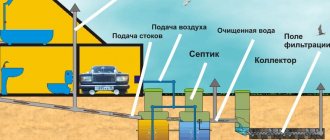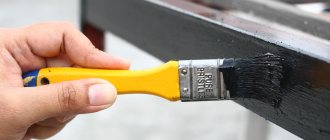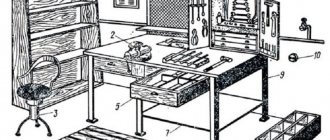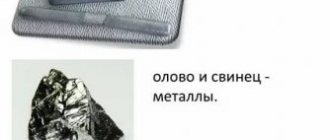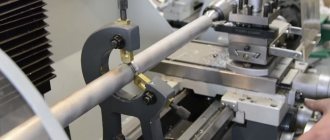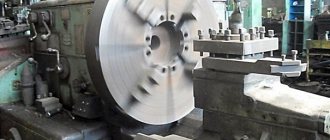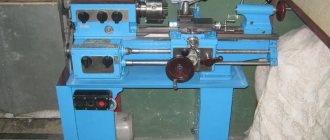Christmas tree equipment for oil and gas wells
In the photo - piping of the Christmas tree fittings
When the structure of the productive formation is represented by rocks with sufficiently high strength, as a rule, the so-called “open” face is used. In such cases, the production string is brought to the upper boundary of the developed formation, and then the formation itself is opened to full capacity.
If the rocks that make up the productive formation are loose and unstable, then in such cases the bottom is strengthened with casing pipes with additional strengthening (using cementation) of the annular area. Oil flow into the well is ensured by perforation (punching holes) in the casing pipe and cement ring, which are located on the productive horizon (as a rule, ten holes are perforated per meter).
In general, the equipment of any wells (not only flowing ones) must ensure a given production selection regime and make it possible to carry out the necessary technological operations to meet the requirements for the protection of subsoil, environmental ecology, and also minimize the risk of emergency situations.
As we said above, such equipment is divided into two types:
- underground (borehole);
- wellhead (ground location).
The Xmas tree is placed on the column head of the wellhead. Such fittings must meet all the requirements of GOST number 13846-89.
Types of fountain fittings differ in their strength characteristics and design features, which are reflected in the code of this equipment.
The piping is a part of the fittings installed on the column piping, which is intended for:
| № | Helpful information |
| 1 | piping one or two pipelines to a well |
| 2 | managing the flow of incoming products and monitoring it in the inter-pipe space |
The upper end of the well pipeline is secured using a pipe holder reel, which is placed on the pipe head. It is possible to fasten such a pipeline using a pipe holder coupling, which is fixed in the pipe head body.
The Xmas tree must provide the ability to measure pressure on the upper Christmas tree buffer, as well as measure the temperature and pressure of the well fluid in the area of the side Christmas tree buffer and at the tubing head. The standards provide for the production of block-type Christmas tree fittings and the possibility of supplementing (if necessary) such fittings with automatic safety devices and other remote-controlled equipment.
If the well is equipped with two strings of tubing of a concentric type (double-row lift), then pipes of large diameters are suspended using a threaded connection on a lower tee or cross, which must hermetically seal the annulus. Pipes of smaller diameters are suspended from the threads of the stem coil (conductor), which are placed above the tee or cross.
The use of a two-string cross or tee tree structure is advisable when stopping the well during its operation is undesirable. Either the top or any of the side strings are used as a working string, and the locking device located first from the barrel is a spare one.
Installation and dismantling of wellhead Christmas tree equipment is carried out using truck cranes or other lifting mechanisms.
Locking devices used on such fittings are of three types:
- plug valve (with lubricant);
- direct-flow valve type ZM or ZMS (with lubrication), equipped with a single-plate gate;
- ZMAD valve equipped with a two-plate gate.
These pipes are lowered into flowing wells to the level of the production casing filter.
GOST number 633-80 provides for the use of tubing with the following nominal external diameters: 27, 33, 42, 48, 60, 73, 89, 102 and 114 millimeters. The wall thickness of such pipes according to GOST varies from three to seven millimeters, and their length - from five to ten meters. Tubing is made seamless, from steel grades that have high mechanical characteristics.
Such pipes are threaded at both ends to ensure a reliable coupling connection. If necessary, tubing is made of aluminum alloy D16. In some cases, non-metallic fiberglass pipes are used, as well as flexible (threadless) pump and compressor pipes, produced in the form of drums with a total length of up to six kilometers.
TYPICAL DIAGRAMS AND MAIN PARAMETERS
1. TYPICAL DIAGRAMS AND MAIN PARAMETERS
1.1. Typical diagrams of fountain trees should correspond to those shown in Figure 1, and of injection trees - in Figure 2.
Damn.1. Typical diagrams of fountain trees
Typical diagrams of fountain trees
1 — sub to the pipe head; 2 - tee; 3 - locking device; 4 — pressure gauge with shut-off and discharge device; 5 - throttle; 6 — counter flange; 7 — crosspiece Drawing 1
Damn.2. Typical diagrams of injection trees
Typical diagrams of injection trees
| Scheme 1 (tee) | Scheme 2 (cross) |
1 — sub to the pipe head; 2 - tee; 3 - locking device; 4 - pressure gauge with shut-off and discharge device; 5 - check valve; 6 — counter flange; 7 — cross
Damn.2
1.2. Typical piping diagrams for Christmas tree and injection valves must correspond to those shown in Figure 3.
Damn.3. Typical piping diagrams for Xmas and injection valves
Typical Xmas tree piping diagrams
injection valves
1 - counter flange; 2 - locking device; 3 - pipe head; 4 — pressure gauge with shut-off and discharge device; 5 - quick-assembly connection Drawing 3
1.3. Typical diagrams of wellhead fittings should be compiled by a combination of standard diagrams of wellhead trees with piping. Examples of typical diagrams of Christmas tree fittings are shown in Fig. 4, of injection fittings - in Fig. 5
Damn.4. Christmas tree diagrams
1 - fountain tree (Fig. 1); 2 - piping (Fig. 3)
Damn.4
Damn.5. Diagrams of injection valves
1 — injection tree (Fig. 2); 2 - piping (Figure 3) Figure 5
1.4. The main parameters of the Christmas tree fixtures must correspond to those indicated in Table 1.
Table 1
| Conditional bore, mm | Working pressure, MPa | ||
| tree trunk | side branches of the tree | side outlets of the pipe head | |
| 50 | 60 | 50 | 14, 21, 35, 70, 105 |
| 65 | 50, 65 | ||
| 80 | 50, 65, 80 | 50, 65 | 14, 21, 35, 70, 105, 140 |
| 100 | 65, 80, 100 | ||
| 150 | 100 | 21 | |
1.5. The main parameters of injection valves must correspond to those indicated in Table 2.
table 2
| Conditional bore, mm | Working pressure, MPa | ||
| tree trunk | side branches of the tree | side outlets of the pipe head | |
| 50 | 50 | 50 | 14, 21, 35 |
| 65 | 50, 65 | 50, 65 | |
| 80 | 65, 80 | 21, 35 | |
1.6. Symbols of wellhead trees and fittings must consist of a name, a code constructed according to the scheme in Appendix 1, and a designation of a regulatory and technical document for delivery. Examples of symbols of Xmas tree with suspension of a well pipeline in a pipe head, with a Christmas tree according to standard scheme 6, with automatic control, with a nominal bore of 80 mm and side branches of 65 mm, for a working pressure of 70 MPa:
Christmas tree fittings AF6A-80/65x70 GOST 13846-89
Trees with a well pipeline suspended in a sub to a pipe head (reel-pipe holder), made according to standard scheme 2, with manual control, with a nominal bore of 65 mm, side branches of 50 mm, for a working pressure of 35 MPa, corrosion-resistant design K2:
Fountain Christmas tree EFK2-65/50x35K2 GOST 13846-89
Injection fittings with suspension of the well pipeline in a sub to the pipe head, made according to standard scheme 1, with manual control, with a nominal diameter of the trunk and side branches of 65 mm, for a working pressure of 21 MPa:
Injection fittings ANK1-65x21 GOST 13846-89
The same, with two pipe heads according to Fig. 4b:
Injection fittings AHK1a-65x21 GOST 13846-89
Injection tree with the same parameters and purpose:
Injection tree ENK1-65x21 GOST 13846-89
Technical requirements for design
GOST 13846–89 determined that Christmas tree equipment is designed to seal wells, block the movement of the working medium and perform other technological procedures. In accordance with the standards regulated in GOST 15150–69, these devices can operate at temperatures from -60 to +40 degrees.
GOST 51365–2009 defines the technical conditions and requirements for the specified fittings. Designers involved in the design of equipment should be guided by the requirements of this document.
Xmas and injection valves AFK, ANK
Home" > "Products" > "Wellhead valves" > "Christmas tree and injection valves AFK, ANK
Christmas tree fittings, produced in accordance with GOST 13846-89 and TU 3665-010-00221801-99, are intended for sealing the mouth of pumping stations (ESP, SRP) and flowing oil and gas wells, shutting off and directing the produced product to the manifold, as well as carrying out the necessary technological operations. The fittings are intended for operation in cold and temperate macroclimatic regions in accordance with GOST 16350-80. Placement category 1 according to GOST 15150-69. Ambient air temperature during operation is from minus 60°C to plus 40°C. Operating temperature range is from -60°C to +120°C. Material class and level of technical requirements (UTT) depending on operating conditions according to GOST R 51365-2009. The well environment, depending on the design, can contain up to 6% CO2 and H2S by volume each. The fittings are certified for compliance with state standards of the Russian Federation (GOST R) and interstate standards (GOST) applied in the territory of the Russian Federation. Has permission for use issued by the Federal Service for Environmental, Technological and Nuclear Supervision. The fittings can be designed and manufactured according to individual orders of consumers, taking into account operating conditions, the selected class of component materials and in the required layout combinations.
| Typical schemes according to GOST 13846-89 | Working pressure, MPa(PSI) | Conditional diameter, mm. (in) trunk and side branches of the tree | Conditional diameter, mm. (in) pipe head side bends |
| AF1, AFK1 | 14(2000), 21(3000), 35(5000), 70(10000), 105(15000) | 50(2.1/16), 65(2.9/16), 80(3.1/8), 100(4.1/16) | 50 (2.1/16), 65 (2.9/16) |
| AF2, AFK2 | |||
| AF3, AFK3 | |||
| AF4, AFK4 | |||
| AF5, AFK5 | |||
| AF6, AFK6 |
1. Cross; 2. Adapter; 3. Gate valve; 4. Flange tee; 5. Wafer tee; 6. Flange adapter; 7. Cable entry; 8. Throttle adjustable; 9. The throttle is unregulated; 10. Retraction; 11. Column flange; 12. Threaded flange; 13. Valve; 14. Pressure gauge.
Main parameters well environment depending on the version (HL, K1, K2): up to 6% CO2 and H2S operating temperature range: from -60°C to +120°C working environment: oil, gas, solution, water operating temperature: - 60°C +120°C climatic version: AA, BB, СС, DD, EE, FF, NN
Cable entry upon request
AFK1-65x21 HL, K1, K2; AFKE1-65x21 HL, K1, K2; AFK2-65Х21 ХЛ, AFK3-65Х21 ХЛ, AFK3-65Х21 ХЛ (9 valves), AFK4-65Х21 ХЛ, AFK5-65Х21 ХЛ, AFK6-65Х21 ХЛ, AFK1-65х35 ХЛ, AFK1-65х35 ХЛ, AFK2-65Х35 ХЛ, AF K3 -65Х35 ХЛ, AFK4-65Х35 ХЛ, AFK5-65Х35 ХЛ, AFK6-65Х35 ХЛ, AFK1-80/65Х21 ХЛ, AFK2-80/65Х21 ХЛ, AFK3-80/65Х21 ХЛ, AFK4-80/65Х21 ХЛ, AFK5-80 /65Х21 ХЛ, AFK6-80/65Х21 ХЛ, AFK1-80/65Х35 ХЛ, AFK2-80/65Х35 ХЛ, AFK3-80/65Х35 ХЛ, AFK4-80/65Х35 ХЛ, AFK5-80/65Х35 ХЛ, AFK6-80/ 65X35 XL, AFK1-80X21 XL, AFK2-80X21 XL, AFK3-80X21 XL, AFK4-80X21 XL, AFK5-80X21 XL, AFK6-80X21 XL, AFK1-80X35 XL, AFK2-80X35 XL, AFK3-80X35 X L, AFK4- 80X35 HL, AFK5-80X35 HL, AFK6-80X35 HL, AFKE1-100X21 HL, AFK2-100X21 HL, AFK3-100X21 HL, AFK4-100X21 HL, AFK5-100X21 HL, AFK6-100X21 HL, AFK1 -100Х35 HL, AFK2- 100X35 HL, AFK3-100X35 HL, AFK4-100X35 HL, AFK5-100X35 HL, AFK6-100X35 HL, AFK6-150/100x21 HL, AFKE1-65x21-19 HL (AFEN), AFK2-65x35, AFK3-65 x35 HL, K1 , K2; AFK6-80/65-21 HL, K1, K2; AFK6-80/65-35 HL, K1, K2; AFK6-80x21 HL, K1, K2; AFK6-80x35 HL, K1, K2; AFK6-100x21 HL, K1, K2; AFK6-100x35 HL, K1, K2; AFK6-150x100-21 HL, K1, K2; AFKE1-65x21-19 HL, K1, K2.
The meaning of fountain pipes
Even with the same amount of gas content in the formation, not every well is capable of flowing. For example, if the volume of such gas is sufficient to ensure flowing in a well of 150 mm in diameter, then it may not be enough for a diameter of 200 mm.
The gas-oil mixture that moves along the wellbore looks like a layer-by-layer alternation of oil and gas layers. Therefore, the larger the diameter of the production pipe string, the greater the amount of gas required to lift the oil liquid through it.
In practice, there have been cases in which wells with large bore diameters (from 150 to 300 millimeters), which were drilled to a depth with highly productive formations with high internal pressure, were distinguished by high flow rates, but even in them, flowing most often continued to be quite a short time. Moreover, in some cases, wells drilled into productive formations with high pressures cannot flow out under normal conditions.
In this regard, in order to make the most efficient use of the energy of the expanding gas, all mine workings where blowouts are possible are equipped before development with lift pipes, the nominal diameters of which vary from 60 to 114 millimeters. It is through these small-diameter pipes that the gas-liquid mixture moves in the drilled well.
The selection of the diameter of lifting (elevator) pipes occurs, as a rule, experimentally, and depends on the following factors of a specific mine working:
- expected well flow rate;
- reservoir pressure value;
- drilling depth;
- specific operating conditions.
During the process of well flowing through a small-diameter pipe string, the gas factor decreases, which makes it possible to extend the flowing time period. In many cases, a well flowing through a pipe string with a diameter of 73, 89 or 114 millimeters first began a regime of periodic emissions, and then it stopped completely. In such cases, the duration of the fountain was extended by replacing these pipe columns with fountain pipes of smaller diameters (33, 42, 48 and 60 millimeters).
Purpose of fountain fittings
Devices of this class are responsible for solving the following engineering and technical problems:
- ensuring well sealing;
- diversion of products transported through the pipeline system;
- to adjust and maintain well flow;
- when providing access to the well bottom;
- to ensure sampling without stopping production processes.
Products of this class are used at high pressures arising under the influence of loads. Fittings are used when there is a possibility of exposure to aggressive environments inside the well. Quite often it is used if the liquid contains a large number of impurities of different origins and sizes.
When using such a system, it is necessary to take into account that this equipment must have a long service life and the necessary margin of safety. The main consumers of these products are enterprises engaged in the production and transportation of hydrocarbons, as well as the construction of pipeline transport systems.
EXAMPLE OF A TYPICAL DIAGRAM OF A CHOWT FIXTURE WITH A CONTROL SYSTEM
1
— control station;
2
— sub to the pipe head;
3
— counter flange;
4 -
pipe head;
5
- manually operated locking device;
6 —
pressure gauge with shut-off and discharge device;
7
— locking device with remote control;
8 —
cross;
9
- adjustable throttle;
10 —
air pilot (automatic safety device)
Note. The diagram does not show sensors for pressure, temperature, gas contamination, etc.
Flowing production of oil wells
Loading …
This process can occur both under the influence of natural energy (Wп), which comes to the bottom of the well along with liquid or gas, and under the influence of energy that is introduced into the well from the surface (Wi).
A mixture of petroleum liquid and associated gas, after passing through the well string, is directed through special wellhead equipment to special devices called separators, in which the liquid oil component is separated from the gas dissolved in it, and to measuring devices that determine the amount of raw material received.
After this, the oil is pumped into field pipelines. To ensure the movement of the hydrocarbon mixture through this pipeline system, a certain pressure value must be maintained at the wellhead.
In this regard, the general formula for energy balance is as follows:
W1+W2+W3 = Wп+Wи
Let's decipher the unfamiliar notation:
W1 is the energy that is spent on lifting the gas-liquid mixture from the bottom to the wellhead;
W2 is the energy that is consumed by this mixture during its movement through the wellhead equipment;
W3 is the energy that is carried away by the gas-liquid stream beyond the wellhead.
Energy transfer Wi is carried out either through air or compressed gas, or using pumping equipment. The first method is called gas lift, and the second – pumping.
This statement is also true for those fields in which the water pressure regime is clearly expressed. This regime is characterized by the content of gas in the oil in a dissolved state, and this gas is not released from the liquid within the productive formation.
Installation and dismantling of fountain fittings
During the operation of an oil or gas well, the structure is installed. Column heads are used for connection. The holes located in the upper flange allow you to fix parts of different sizes. The equipment installation process is carried out in several steps.
A gasket made of low-carbon steel and having an oval shape is placed in the space between the flanges. Using an elevator, the pipe string is lowered to the installation site. After this, the pipes are assembled together using threaded connections. By the way, it makes sense to coat the threads with a protective lubricant before assembly. After completing assembly of the installation, it is necessary to carry out pressure testing.
The Christmas tree fittings and their piping scheme are designed so that they can protect the environment from the influence of the working medium supplied in the pipeline system.
APPENDIX 3 (recommended). EXAMPLE OF A TYPICAL DIAGRAM OF A CHOWT FIXTURE WITH A CONTROL SYSTEM
APPENDIX 3 Recommended
1 — control station; 2 — sub to the pipe head; 3 — counter flange; 4 - pipe head; 5 — manually operated locking device; 6 — pressure gauge with shut-off and discharge device; 7 — locking device with remote control; 8 — cross; 9 - adjustable throttle; 10 — air pilot (automatic safety device)
Note. The diagram does not show sensors for pressure, temperature, gas contamination, etc.
Related Posts via Categories
- How to calculate the cross-sectional area of reinforcement of all types?
- How much does 1 meter of construction rod reinforcement of various types weigh?
- Length of rod reinforcement - all possible options regulated by GOSTs
- Linear fittings – high-quality installation of power lines is guaranteed!
- Unmeasured reinforcement is the best option for low-rise construction!
- Brands and classes of construction rod reinforcement and wire for reinforcement
- Coupling fittings, what they are and what they are used for
- Anchoring reinforcement in concrete is a complex but important operation
- Hot-rolled reinforcement - GOST and the entire life cycle of the product
- Weight and features of steel corrugated reinforcement A3 and other classes
